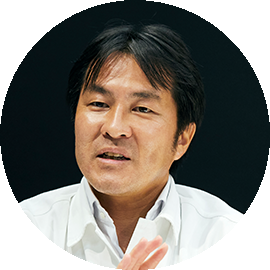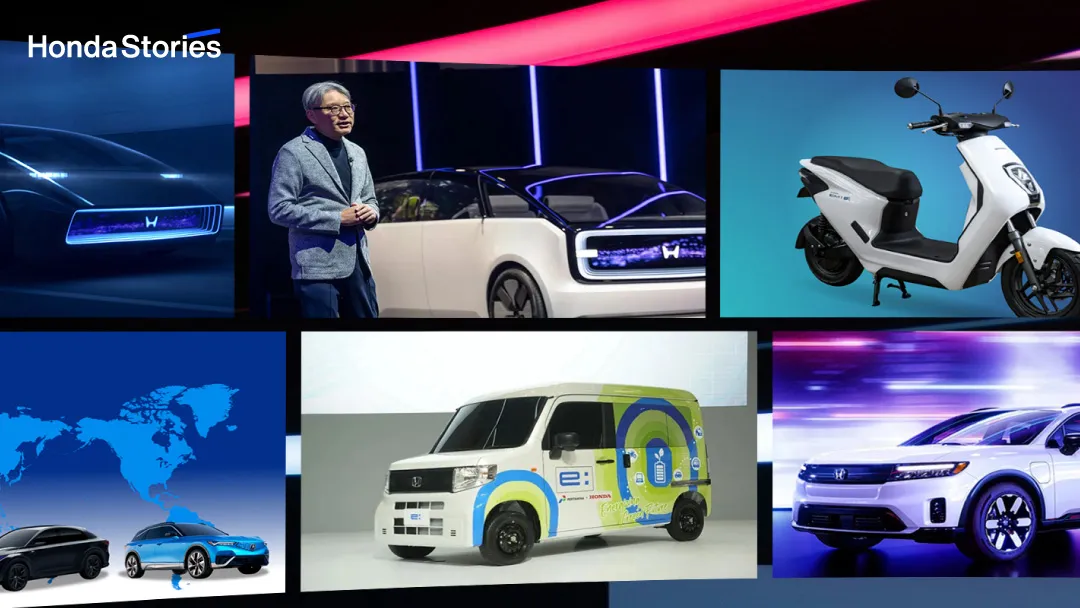The new commercial-use mini-EV (electric vehicle) “N-VAN e:”, based on the “N-VAN” is set to be released in spring 2024. As part of the final verification process leading up to its debut six months later, practicality verification with prototypes is currently being conducted in collaboration with Yamato Transport Co., Ltd. The development leader for the power unit of the N-VAN e: smiles, stating "We have achieved positive results”.

Shinichiro Watanabe
Read MoreChecking the validity of the performance as a new commercial-use mini-EV in the field of delivery
Since its debut in 2018, the light van “N-VAN” has garnered support not only from commercial users but also from hobbyists who enjoy activities such as camping and overnight stays in their cars. The EV (electric vehicle) version of the “N-VAN” will finally be available for sale in Japan in April 2024.
Chief Engineer Shinichiro Watanabe, who is leading the development of the power unit for N-VAN e:, reflects on his mindset at the start of development in 2021, saying, “I was a bit surprised to start with a light commercial vehicle, but I felt a sense of accomplishment in electrifying the popular N series domestically and meeting the high demand from corporate customers.”
The development team’s mission was to transition the high-quality body package of the gasoline-powered N-VAN to an environmentally friendly EV and deliver it to customers at an affordable price.

In the early stages of developing the electric version of the commercial light van, we conducted interviews with various corporate customers to understand the performance expectations for the product. Furthermore, using big data collected through Honda’s proprietary communication-type navigation system “internavi LINC”, we set target values while anticipating how commercial vehicles would be utilized when replaced with EVs, and proceeded with product development.
However, since we were primarily considering based on gasoline powered vehicle drive data, as a way to verify whether we correctly understood how customers use it and whether our hypotheses (goals) were accurate, we wanted customers to actually use it to confirm the validity of our set goals and performance.
 The N-VAN e: (prototype) used in practicality verification with Yamato Transport. Positive feedback was obtained from drivers who actually used it.
The N-VAN e: (prototype) used in practicality verification with Yamato Transport. Positive feedback was obtained from drivers who actually used it.
Yamato Transport, a leading delivery service company, was chosen as a partner to validate the prototype’s potential on public roads. Like Honda, Yamato Transport is earnestly working towards achieving carbon neutrality, including the substantial reduction of greenhouse gas emissions to zero by 2050.

Yamato Transport and Honda shared a common awareness of the necessity to avoid polluting the air through their corporate activities and products, as well as the importance of actively addressing environmental issues. In addition, Yamato Transport places emphasis on the usability of delivery vehicles to reduce the burden on drivers. They also aim to address the continuously rising fuel costs and promote the introduction of reliable EVs. In such a context, when we informed Yamato Transport about Honda’s plan to release a new commercial-use mini-EV in spring 2024, they expressed a high level of anticipation, saying, “If there is such a vehicle, we would like to actually use and test it”.
Both companies share this mindset, and in order to test whether the EV is truly usable at the forefront of delivery, where it undergoes more demanding use than in typical households, it was decided to have them try it out. This will allow us to gather information from areas that cannot be captured by big data alone.
Insights gained from practicality verification
The practicality verification for N-VAN e: took place at three branch offices: Nakano (Tokyo), Kiyohara, Utsunomiya (Tochigi), and Suma, Kobe (Hyogo). Testing has been taking place since June 2023.

Customers were seeking a practical range that they could rely on for driving the N-VAN e:. We translated that into WLTC mode values (an internationally standardized test method for measuring electric energy consumption and fuel efficiency) and set a development goal of 210 km or more on a full charge.
We believed that this performance would meet the needs of Yamato Transport’s collection and delivery operations. However, the load on the vehicles varies significantly depending on the region (collection and delivery vehicle routes and road conditions). If it becomes a commercial vehicle, there will be a demand for performance that is not limited to specific regions. Therefore, we chose Nakano, an urban area with frequent stop-and-go traffic, Utsunomiya, a suburban area where the distance covered in a single delivery increases, and Suma in Kobe, a hilly region where the load on the vehicle increases. These locations have different characteristics, and we selected them in collaboration with Yamato Transport.
In the practicality verification, we installed a real-time vehicle monitoring system on the test vehicles. This system measures approximately 700 points of information every 1/10 second, including the state of key components for EVs such as the battery and motor, as well as driver operations such as vehicle speed, accelerator and brake pedal input, and even actions such as opening and closing doors. The data is linked with location information. At each location, we were able to collect driving data tailored to the characteristics of the respective regions. The results confirmed that our hypotheses set during the early stages of development were correct, providing validation and verification.
 Dashboard of the vehicle monitoring system. This allows for the actions of the three prototypes targeted for practicality verification to be checked in a consolidated manner
Dashboard of the vehicle monitoring system. This allows for the actions of the three prototypes targeted for practicality verification to be checked in a consolidated manner
 This captures not only accelerator and brake operations but also information about door use, and air conditioning
This captures not only accelerator and brake operations but also information about door use, and air conditioning
 Due to its link with location information, it is useful not only for collection and delivery tasks but also for the optimization of driving the EV itself
Due to its link with location information, it is useful not only for collection and delivery tasks but also for the optimization of driving the EV itself
The practicality verification has been progressing smoothly without any particular issues. In the context of this verification, the anticipated benefit of electrification is a fuel cost reduction of approximately 60,000 yen per commercial vehicle per year. Furthermore, by continuing to conduct interviews with drivers, they can confirm aspects such as usability and impressions of electric vehicles that may not be readily apparent in numerical data.

In the midst of the calls for SDGs, associated ESG investments, and responses to soaring fuel costs, the adoption of electric vehicles is recognized as a more urgent challenge for corporations than for the general public. However, particularly for small-scale business owners who have little exposure to electric vehicles, there remains a lingering concern, “Is an electric vehicle really practical for us to use?”
The specific results obtained from the practicality verification, such as the reduction in fuel costs and the practical driving range in collection and delivery tasks, now allow us to confidently say that this vehicle is usable for those who may have concerns about adopting electric vehicles.
 Calculations in situations where there are significant differences in outdoor temperatures between the summer and winter. The vehicle is designed to last until the end of the business day on a single battery charge, regardless of the season
Calculations in situations where there are significant differences in outdoor temperatures between the summer and winter. The vehicle is designed to last until the end of the business day on a single battery charge, regardless of the season

Providing a lively and agile driving experience is an integral part of Honda’s approach to car manufacturing. In this case, the development is also taking into account the ease of handling for accelerator and brake operations when the vehicle is under load, while incorporating the power characteristic of an EV.
Drivers have also noted that there is ample power, even when the vehicle is loaded with cargo, with smooth driving performance in response to accelerator/brake operation. Drivers have provided positive feedback, mentioning aspects such as the reduction of stress associated with concerns about engine noise during acceleration, which they had to be mindful of in their previous tasks.
It seems that drivers considering switching to their first EV will be satisfied with this vehicle. Please, look forward to it.
Can the N-VAN e: handle the intense traffic of Jakarta?
Based on the data obtained from practicality verification with Yamato Transport, the N-VAN e: is currently in the midst of quality refinement for mass production. However, without any time for rest, the practicality verification has been conducted in the capital city of Indonesia, Jakarta, since mid-September. Our partner for this is the state-owned oil and gas company, Pertamina.
 N-VAN e: (prototype) used in practicality verification in Indonesia
N-VAN e: (prototype) used in practicality verification in Indonesia

Pertamina is a well-known company in Indonesia that operates gas stations. They advocate the concept of "Green Energy Stations" and are actively addressing environmental issues. Pertamina, aiming to reduce CO2 emissions in its business activities, found common ground with Honda, which sought to verify EV performance in challenging environments. This alignment of needs led to the collaboration for practicality verification.
One of the reasons for choosing Jakarta as the test site is that the average temperature throughout the year is higher than in Japan. Another reason is the prevalence of intense traffic congestion, to the extent that there is a law known as the "Odd-Even Policy", where roads that can be used depend on whether the date or the last digit of the license plate is odd or even. Additionally, the traffic conditions involve maintaining incredibly close following distances, which is uncommon in Japan. This results in exposure to the heat emitted by other vehicles, making it a somewhat challenging environment for EVs. To withstand high outdoor temperatures and intense traffic conditions, high reliability is required for the batteries and motors. Through verification in such harsh conditions, we aim to further enhance the completeness of the vehicle.
The data obtained and analyzed during practicality verification will be implemented in the N-VAN e: and the final adjustments for commercialization will commence. When spring arrives, the lively presence of the N-VAN e: running around the city is expected to increase interest in light electric vehicles, regardless of whether people are driving or not.
 Watanabe enjoys outdoor sports and spends his weekends going to the sea and mountains. He emphasizes that since time during the weekend is limited, he doesn’t want the car to be a source of stress. He is looking forward to future goals on how to reduce “EV-specific unnecessary waiting time”, such as charging, during travel.
Watanabe enjoys outdoor sports and spends his weekends going to the sea and mountains. He emphasizes that since time during the weekend is limited, he doesn’t want the car to be a source of stress. He is looking forward to future goals on how to reduce “EV-specific unnecessary waiting time”, such as charging, during travel.
Original article issued on September 28, 2023
<Related Articles>





![[Interview] N-VAN Goes Electric! Four Project Leaders of the Development Team Reveal the Behind the Scenes of the Mini-EV Development Challenges](/content/dam/site/global-en/stories/cq_img/076/social.jpg)





This EV is a crucial model for achieving carbon neutrality. Light vans are closer to people’s lives, so there was a sense of fulfillment in working on them.